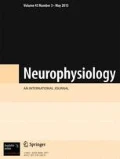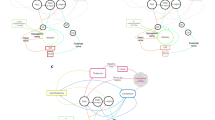Abstract
The effect of electrical stimulation was studied on the nucleus of the tractus solitarius, the nucleus cuneatus, and the dorsal motor nucleus of the vagus nerve, i.e., structures of the bulbar cardiovascular sector in which it has been postulated that impulses from the sinoaortic reflexogenic zone are relayed to the cardiovascular system. Stimulation of all the structures tested in acute experiments on cats under chloralose-Nembutal anesthesia evoked depressor responses of varied degree, the hemodynamic basis of which was a decrease in the cardiac output (CO). The effect of stimulation of the nucleus cuneatus on the development of the negative chronotropic effect was observed. The dorsal motor nucleus of the vagus nerve in cats is not the only or even the principal zone from which negative chronotropic influences are exerted on the heart.
Similar content being viewed by others
Literature cited
A. M. Blinova, N. K. Saradzhev, and F. D. Sheikhon, "Functional organization of the bulbar vasomotor center," Byull. Èksperim. Biol. i Med.,55, No. 4, 3 (1963).
A. V. Val'dman, "Functional heterogeneity of the bulbar vasomotor center," in: Central Regulation of the Circulation (Proceedings of the First All-Union Symposium) [in Russian], Leningrad (1970), pp. 64–70.
A. I. Vyshatina, "Changes in the regional blood flow during electrical stimulation of the reticular vasomotor structures of the medulla," Fiziol. Zh. SSSR,56, 733 (1970).
M. I. Gurevich, S. A. Bershtein, D. A. Golov, and M. M. Povzhitkov, "Determination of the cardiac output by the thermodilution method," Fiziol. Zh. SSSR,53, 350 (1967).
M. I. Gurevich, "The cardiac output and its relationship to other parameters of the hemodynamics," in: Physiology of the Cardiac Output [in Russian], Naukova Dumka, Kiev (1970), pp. 80–87.
F. V. Ovsyannikov, "Tonic and reflex centers of vascular nerves," Selected Works [in Russian], Vol. 57, Moscow (1955), p. 57.
M. M. Povzhitkov, "Changes in the cardiac output during stimulation of various structures in the medulla," Dokl. Akad. Nauk SSSR,184, 754 (1969).
N. N. Preobrazhenskii, "Microelectrode recording from neurons of the vasomotor center," Fiziol. Zh. SSSR,51, 164 (1965).
K. A. Smirnov, "Relationship between the various structures of the medulla and the vasomotor center," Fiziol. Zh. SSSR,56, 359 (1970).
V. M. Khayutin, "Current concepts in the physiology of the vasomotor center," in: Current Problems in the Physiology and Pathology of the Circulation [in Russian], Moscow (1961), pp. 193–233.
R. S. Alexander, "Tonic and reflex functions of medullary sympathetic cardiovascular centers," J. Neurophysiol.,9, 205 (1946).
F. R. Calaresu and M. K. Cottle, "Origin of cardiomotor fibers in the dorsal nucleus of the vagus in the cat," J. Physiol. (London),176, 252 (1965).
F. R. Calaresu and J. W. Pearce, "Electrical activity of efferent vagal fibers and dorsal nucleus of the vagus during reflex bradycardia in the cat," J. Physiol. (London),176, 228 (1965).
C. G. Chai and S. C. Wang, "Localization of central cardiovascular control mechanism in lower brain stem of the cat," Amer. J. Physiol.,202, 25 (1962).
M. K. Cottle, "Degeneration studies of the primary afferents of IX and X cranial nerves in cat," J. Comp. Neurol.,122, 329 (1964).
W. E. Crill and D. J. Reis, "Distribution of carotid sinus and depressor nerves in cat brain stem," Amer. J. Physiol.,214, 269 (1968).
C. Dittmar, "Ein neuer Beweis fur die Reisbarkeit der centripetaler Endfässern des Ruckenmarks," Akad. Wiss. Leipzig, Math.-Phys. Kl. Ber.,22, 18 (1870).
B. Folkow et al., "Changes in cardiac output upon stimulation of the hypothalamic defence area and the medullary depressor area in the cat," Acta Physiol. Scand.,72, 220 (1968).
C. G. Gunn et al., "Vagal cardiomotor mechanisms in the hind brain of the dog and cat," Amer. J. Physiol.,214, 258 (1968).
D. R. Humfrey, Regions of the Medulla Oblongata Mediating Carotic Sinus Baroreceptor Reflexes. An Electrophysiological Study, Univ. Washington Press, Seattle (1966).
H. P. Koepchen et al., "Neuronale Aktivität im unteren Hirnstamm mit Beziehung zum Kreislauf," Pflüg. Arch. Ges. Physiol.,294, 40 (1967).
S. Middleton and S. Woolsey, "Electrocardiogram-related neural activity in the medulla of the cat," Physiologist,8, 235 (1965).
G. A. G. Mitchell and R. Warwick, "The dorsal vagal nucleus," Acta Anat.,25, 371 (1955).
B. Uvnas, "Central cardiovascular control," in: Handbook of Physiology, Section 2, Neurophysiology, Amer. Physiol. Soc., Washington (1960), pp. 1131–1162.
Additional information
A. A. Bogomolets Institute of Physiology, Academy of Sciences of the Ukrainian SSR, Kiev. Translated from Neirofiziologiya, Vol.3, No.6, pp.631–636, November–December, 1971.
Rights and permissions
About this article
Cite this article
Gurevich, M.I., Shapoval, L.N. Hemodynamic changes during electrical stimulation of some bulbar cardiovascular structures. Neurophysiology 3, 471–475 (1971). https://doi.org/10.1007/BF01063760
Received:
Issue Date:
DOI: https://doi.org/10.1007/BF01063760




